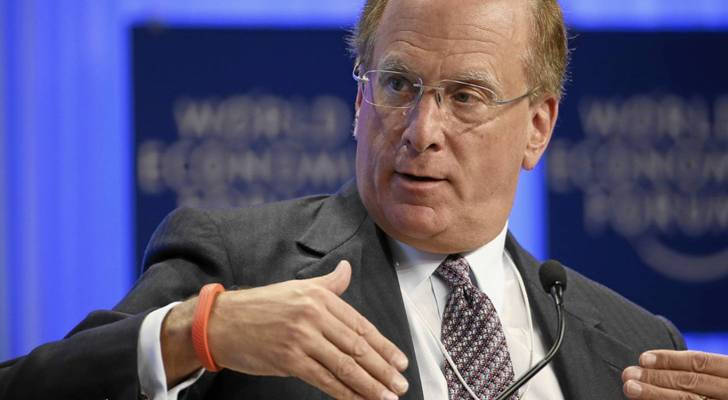
Just when people are more worried than ever about their investments, even to the point of cashing them out, BlackRock Inc. CEO Larry Fink says it’s time to go all in.
But he has a specific investment in mind: private equity, also known as alternative investments.
BlackRock (BLK) has long been known for its low-cost stock index funds, or exchange-traded funds (ETFs), but Fink sees a big future in higher-fee private assets that aren’t listed on the stock markets.
“The solution isn’t to abandon markets,” he wrote in his annual letter to investors.
“It’s to expand them, to finish the market democratization that began 400 years ago and let more people own a meaningful stake in the growth happening around them.”
Fink has overseen BlackRock’s rise to the world’s largest money management firm with more than US$10 trillion in assets. He also serves on the board of the World Economic Forum, and believes opening up private-equity markets will help reduce the gap between rich and poor.
More asset management firms offering private equity
Fink notes that up until recently only wealthy people could invest in infrastructure projects like data centres, ports and power grids — even real estate projects and private credit were hard to access for the non-accredited investor. That’s because these large-scale investment projects usually require cooperation between private firms, government agencies and stakeholders — and due to their complexity are rarely available as investment options through through shares on a stock exchange.
To find a way to access these investment opportunities fund managers found opportunities using private equity. Among the asset management companies forging a path to these opportunities are Blackstone (BX), Apollo (APO) and KKR (KKR) — all offering regular investors access to private equity investment opportunities.
At this point in time, Fink is so bullish on this asset class that he steered his firm to take a lead position. Last year, BlackRock acquired Global Infrastructure Partners for US$12.5 billion and data firm Prequin for US$3.3 billion. The firm is also wrapping up a US$12-billion deal for private credit company HPS Investment Partners.
Together, these investments will help BlackRock manage US$600 billion in alternative assets.
Updating the traditional portfolio mix to private equity
Fink suggested that the traditional 60/40 portfolio of 60% stocks and 50% bonds may no longer be enough to diversify effectively.
Going forward, Fink suggests investors consider a new portfolio mix with 50% in stocks, 30% in bonds, and 20% in private assets like real estate, private credit and infrastructure.
To help retail investors tap into these markets, BlackRock started rolling out model portfolios that include private equity and credit funds alongside traditional assets like stocks and bonds.
These portfolios, which average 15% exposure to private assets, are now available to those invested in the U.S. stock market.
How can investors get exposure to private equity?
While it’s possible to invest in BlackRock fund traded on an American stock exchange, investors will need to consider the impact of withholding tax, as well as currency fluctuations.
For investors who would prefer to avoid U.S. withholding tax and currency exchange fees, consider investing in exchange-trade fund (ETF) with exposure to private equity. Good examples include:
iShares Diversified Monthly Income ETF (XTR): This fund aims to provide consistent monthly cash distributions with the potential for modest long-term capital growth. Best suited for investors seeking regular monthly income. Primary holdings include Canadian iShares ETFs that offer exposure to a diversified portfolio of income-bearing investments.
- Asset Allocation (as of March 31, 2025): 40% equities, 50% fixed income, 10% real estate investment trusts (REITs).
- Top Holdings: iShares Canadian Financial Monthly Income ETF, iShares Canadian Corporate Bond Index ETF, iShares Canadian Real Estate ETF.
- Best suited for investors seeking regular monthly income.
iShares Core Income Balanced ETF Portfolio (XINC): Seeks to provide long-term capital growth and income by investing primarily in one or more ETFs managed by BlackRock Canada.
- Asset Allocation: 80% fixed income, 20% equities.
- Top Holdings: For fixed income: iShares Core Canadian Universe Bond Index ETF (XBB), iShares Core Canadian Short Term Corporate Bond Index ETF (XSH), iShares U.S. Treasury Bond ETF (GOVT), iShares Broad USD Investment Grade Corporate Bond ETF (USIG). For equities: iShares Core S&P/TSX Capped Composite Index ETF (XIC), iShares Core S&P Total U.S. Stock Market ETF (ITOT), iShares Core MSCI EAFE IMI Index ETF (XEF), iShares Core MSCI Emerging Markets IMI Index ETF (XEC).
- Best suited for investors looking for a low-cost, diversified exposure to a broad range of asset classes and regions with a conservative goal of regular income.
The easiest way to get access to these or other ETFs with private equity exposure is to open a discount brokerage account. One good option is to build your own investment portfolio with Investor’s Edge online and mobile trading platform and enjoy low commissions. Get up 100 free online equity trades when you open a CIBC Investor’s Edge account using promo code EDGE100. Offer ends September 30, 2025. Conditions apply.
Bottom line
While these new investment opportunities are exciting, investors need consider the risks and additional costs associated with this new portfolio strategy. For instance, investing in private assets can result in higher management fees, less liquidity, and more complexity compared to traditional investments. That means you might not be able to access your money as quickly, so consider your financial goals before diving in.
To keep up with changes in private-market investments and diversification, check out trusted government and financial resources on the subject.
Before you make any moves, it’s always a good idea to chat with a financial advisor who can help you figure out whether private-equity investment fits with your risk tolerance and long-term goals.
Sources
1. BlackRock: Larry Fink’s 2025 Annual Chairman’s Letter to Investors
This article provides information only and should not be construed as advice. It is provided without warranty of any kind.